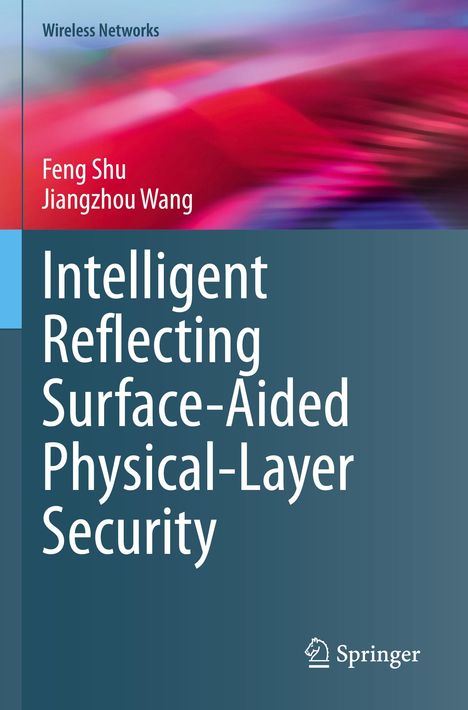Feng Shu: Intelligent Reflecting Surface-Aided Physical-Layer Security, Kartoniert / Broschiert
Intelligent Reflecting Surface-Aided Physical-Layer Security
(soweit verfügbar beim Lieferanten)
- Verlag:
- Springer, 10/2024
- Einband:
- Kartoniert / Broschiert, Paperback
- Sprache:
- Englisch
- ISBN-13:
- 9783031418143
- Artikelnummer:
- 12052093
- Umfang:
- 260 Seiten
- Gewicht:
- 400 g
- Maße:
- 235 x 155 mm
- Stärke:
- 15 mm
- Erscheinungstermin:
- 29.10.2024
- Hinweis
-
Achtung: Artikel ist nicht in deutscher Sprache!
Weitere Ausgaben von Intelligent Reflecting Surface-Aided Physical-Layer Security |
Preis |
|---|
Klappentext
Contents 1 Intelligent Reflecting Surface-aided Physical-layer Security Communications.- 1.1 Overview of Physical-layer Security.- 1.2 Overview of Intelligent Reflecting Surface.- 1.3 Organization of the Monograph.- References.- 2 Enhanced Secrecy Rate Maximization for Directional Modulation Networks via IRS.- 2.1 Introduction.- 2.2 System Model.- 2.3 Proposed high-performance GAI-based Max-SR method.- 2.3.1 Optimize the beamforming vectors v1 and v2 given the IRS phase-shift matrix ¿¿¿¿.- 2.3.2 Optimize IRS phase-shift matrix ¿¿¿¿ given the beamforming vectors.- 2.3.3 Overall Algorithm.- 2.4 Proposed low-complexity NSP-based Max-SR method.- 2.4.1 Optimization of beamforming vectors given IRS phase-shift matrix ¿¿¿¿.- 2.4.2 Optimization of IRS phase-shift matrix ¿¿¿¿ with given beamforming vectors.- 2.4.3 Overall Algorithm.- 2.5 Simulation and Discussion.- 2.5.1 Impact of the Number of IRS Phase-shift.- 2.5.2 Impact of the IRS Location.- 2.6 Conclusion..- References.- Contents 3 High-performance Estimation of Jamming Covariance Matrix for IRS-aided Directional Modulation Network with a Malicious Attacker.- 3.1 Introduction.- 3.2 System Model.- 3.3 Proposed Three Estimation Methods.- 3.3.1 Proposed EVD method.- 3.3.2 Proposed PEM-GD method.- 3.3.3 Proposed PEM-AO method.- 3.3.4 Computational Complexity Analysis and CRLBs.- 3.4 Simulation results and Discussions.- 3.5 Conclusion.- References.- 4 Beamforming and Power Allocation for Double-IRS-aided Two-Way Directional Modulation Network.- 4.1 Introduction.- 4.2 System Model and Problem Formulation.- 4.3 Proposed Transmit Beamforming Methods.- 4.3.1 Proposed GPG Method of Synthesizing the Phase-Shifting Matrices at Two IRSs.- 4.3.2 Proposed Max-SV Method.- 4.3.3 Generalized leakage method 4.4 Proposed HICF Power Allocation Strategy.- 4.4.1 Problem formulation.- 4.4.2 2D-ES and 1D-ES PA strategies.- 4.4.3 Proposed HICF PA strategy.- 4.5 Simulation Results andDiscussions.- 4.6 Conclusion.- 4.7 Appendix.- References.- 5 Beamforming and Transmit Power Design for Intelligent Reconfigurable Surface-aided Secure Spatial Modulation.- 5.1 Introduction.- 5.2 System Model.- 5.2.1 IRS-Aided Secure Spatial Modulation System.- 5.2.2 Problem Formulation.- 5.3 Approximation of the Ergodic Mutual Information.- 5.3.1 Traditional Approximate Secrecy Rate Expression.- 5.3.2 Proposed Newly Approximate Secrecy Rate Expression.- 5.4 Beamforming Design for given transmit power based on Approximate expression of SR.- 5.4.1 Proposed Max-NASR-SCA.- 5.4.2 Proposed Max-NASR-DA.- 5.4.3 Proposed Max-TASR-SDR method.- 5.5 Transmit Power Design for Given Beamforming based on Approximate Expression of SR.- 5.5.1 Transmit Power Design based on Proposed NASR.- 5.5.2 Transmit Power Design based on TASR.- 5.6 Complexity Analysis.- 5.7 Simulation Results and Analysis.- 5.7.1 Rayleigh fading channel.- 5.7.2 Rayleigh fading channel considering path loss.- 5.8 Conclusion.- References.- 6 IRS-Aided Covert Wireless Communications with Delay Constraint.- 6.1 Introduction.- 6.2 System Model.- 6.2.1 Considered Scenario and Assumptions.- 6.2.2 Binary Hypothesis Testing at Willie.- 6.2.3 Transmission from Alice to Bob.- 6.3 Covert Communication Design with Global Channel State Information.- 6.3.1 Optimization Problem and Perfect Covertness Condition.- 6.3.2 Joint Transmit Power and Reflect Beamforming Design.- 6.3.3 Low-Complexity Algorithm.- 6.4 Covert Communication Design without Willie's instantaneous CSI.- 6.4.1 Expression for Covertness Constraint.- 6.4.2 Optimal Design without Willie's Instantaneous CSI.- 6.5 Numerical Results.- 6.5.1 With Global CSI.- 6.5.2 Without Willie's Instantaneous CSI.- 6.6 Conclusion.- 6.7 Appendix.- 6.7.1 Proof of Theorem 6.1.- 6.7.2 Proof of Lemma 6.1.- 6.7.3 Proof of Theorem 6.2.- References.- 7 Intelligent Reflecting Surface Aided Secure Transmission wi

